FROM PRE-CHOICE SEQUENCES TO FREE SPARRING
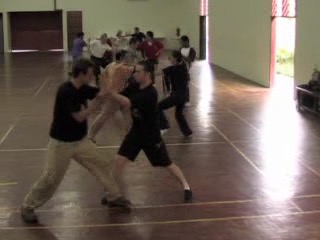
Participants practice free sparring using typical kungfu forms
You have learnt the combat sequences well and can perform them smoothly. How are you going to use them in free sparring so that you use typical kungfu patterns in attack and defence correctly and spontaneously?
These are two main problems in free sparring most kungfu practitioners today face:
- How to use kungfu patterns and not free-style fighting
- How to use them correctly and spontaneously.
We in Shaolin Wahnam are very lucky to have a sparring methodology that can overcome these two problems. We have two main methods, namely the “Eight-Stage Approach” and “Subtraction and Addition”.
The "Eight-Stage Approach" consists of the following:
- Pre-Choice
- Self-Choice
- Surprised Counters
- Continuation
- Modifications and Variations
- External Change
- Internal Change
- Free Sparring
(Please note that our sparring methodology is constantly being improved upon. Hence, the number of stages and terms used may be slightly different at different periods.)
"Subtraction and Addition" naturally consists of
- Subtraction
- Addition
(Please note that "Subtraction and Addition" is a recent innovation. Early students may not have heard of this term though they used this method.)
Either "Eight-Stage Approach" or "Subtraction and Addition" can lead us to free sparring using kungfu forms correctly and spontaneously. But we use both methods.
This video series records some of these lessons.
Linking Sequences for Continuous Attacks
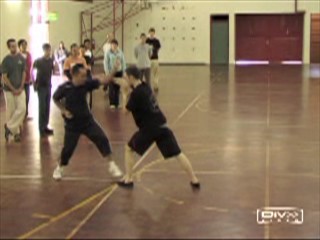
You can link all the four sequences of Combat Sequences 1 to 4 into a continuous attack. Amongst other benefits, this helps to review all the four sequences learnt.
Linking Combat Sequences 5 to 8
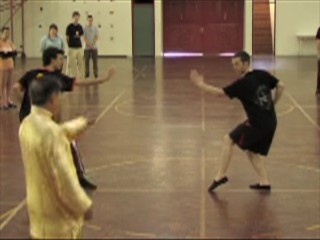
You can link Combat Sequences 5 to 8 into a continuous attack. Your opponent will be overwhelmed by the variety of techniques.
Continuous Attacks with Kicks
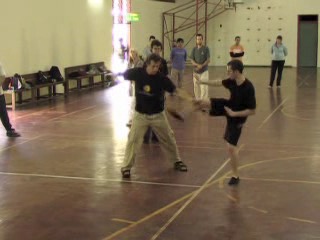
You can link Combat Sequences 9 to 12 together in a continuous attack. Please note that the video clips shows up to Sequence 11 only. These attacks focus on kicks. But unlike in Taekwondo, in kungfu the practitioner opens the ways for kicks with hand attacks.
Without Neglecting Form and Force in Slowing Down

Participants often slow down for some specific purposes. Slowing down does not mean that the participants would neglect their form and force.
Changing from Right to Left Leg Mode

Ben links Combat Sequences 13 and 14 into a continuous flow. After Sequence 13 which ends with the right leg mode, how would Ben continue with Sequence 14 which starts with the left leg mode?
An Example of Subtraction and Addition
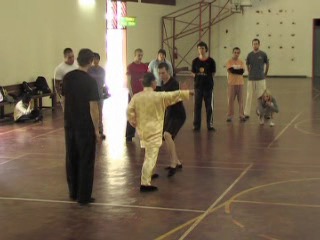
You can change from the right leg mode at the end of Sequence 14 to the left leg mode at the start of Sequence 15. The initiator presses in with the next attack after “Precious Duck”, without waiting for the responder to execute a “Black Tiger” according to the prescribed sequence. In other words, after “Precious Duck” the initiator continues with Sequence 15. This is an example of “Subtraction and Addition”. The initiator subtracts a pattern from Sequence 14, and adds Sequence 15 to it.
The Grandmaster is Almost Caught Off-Guard
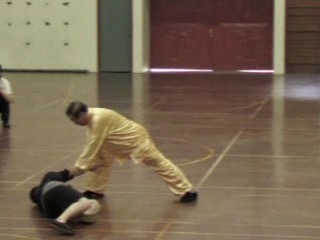
Grandmaster Wong pauses to explain some points but Sifu Jamie continues to attack. He almost catches Grandmaster Wong off-guard but due to his good training the grandmaster recovers himself and turns the table back on Sifu Jamie instead, winning impromptu loud applaud from the participants.
Subtraction and Addition

The initiator starts with two sequences with the option to subtract or add, after which the responder continues with one sequence also with the option to subtract and add.
LINKS
Review of the Intensive Shaolin Kungfu Course in Sabah in March 2007
- Overview 1 : The Fundamentals
- Overview 2 : The 16 Combat Sequences
- Overview 3 : Are They Performing Kungfu Dance?
- The Basics of Shaolin Kungfu Training
- Fundamental Combat Skills
- Defeat you Hand to your Opponent, Victory you Create Yourself
- Avoiding Disadvantages and Seeking Advantages
- Basic Principles and Tactics of Combat
- Skills derived from Sparring can be Rewardingly used in Daily Life
- Some Secrets in Practicing Genuine Kungfu
-
Various Ways to Move into an Opponent
- Applying Combat Sequences in Sparring
- Linking Sequences to be More Combat Efficient
- The Secrets of Continuous Cannons
- The Mechanics of Continuation
- Marvelous Techniques Beget Marvelous Techniques
- Perfecting Forms and Developing Force
- Applying Tactics in Combat
-
Objectives of Form Training in Solo
- Being Fluent in Kicking Techniques before Applying them in Combat
- Using Tactics in Kicking Attacks and Defences
- Different Levels of Sophistication in Sparring and Fighting
- The Legacy of Uncle Righteousness: Secret of Continuous Cannons and their Counters
-
Benefiting from the Experiences and Teachings of Past Masters
- Poetic Patterns Can be Very Deadly
- Moving Back One Step when in Diffiuclt Situations
- Linking Sequences to Form a Kungfu Set
- Felling Techniques in Kungfu are Different from Judo and Wrestling
- Butterfly Palms and Hiding Flowers are Excellent in Countering Felling and Gripping Attacks
-
Let Mercy Flow from the Hands
- Benefits of Solo Set Practice — Combat Sequences 13 to 16
- From Pre-Choice Sequences to Free Sparring
- Applying Shaolin Patterns Correctly and Spontaneously in Free Sparring
- Shaolin Kungfu against Boxing and Kick-Boxing
- Shaolin Counters against Wrestling Shoots
- The Secret of Grandmaster Ho Fatt Nam
- Why Shaolin Kungfu is Technically Faster than Boxing
- Shaolin Techniques, Tactics and Strategies against Boxing
- Revealing Secrets of Past Taijiquan Masters
- Overwhelming Opponents with Just One Pattern
- Poetry and Elegance in Effective Combat
